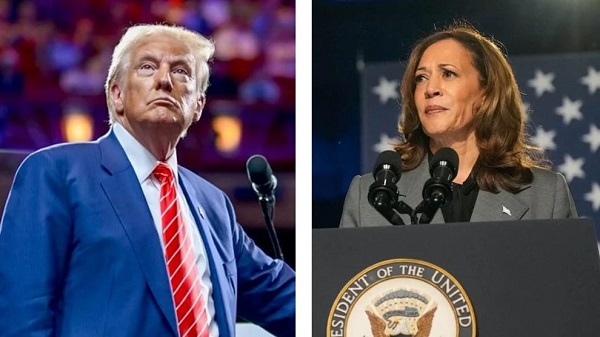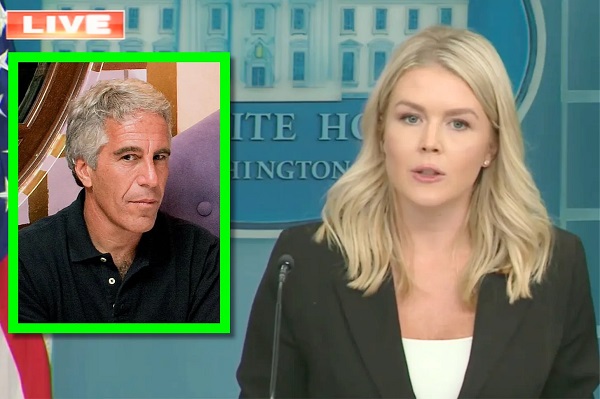Opinion
The majority of voters have moved on from legacy media and legacy narratives

From EnergyNow.ca
By Margareta Dovgal
A Wake-Up Call for Political Strategists Across the Continent
For only the second time in US history, a president has lost, left office, and won re-election. For most Canadians watching the US election, the news of Donald Trump’s impending return to the White House comes with some degree of disappointment – and confusion.
Rather than getting caught up in doomsaying as there’s enough of that going around, I wanted to share some thoughts on what I would hope Canadians working in and around politics and policy come away with.
Speaking to the heart shouldn’t neglect speaking to the wallet
Biden probably should have resigned sooner, and Harris should have gone through a competitive primary race before carrying the flag. Hindsight is 20/20, and I doubt that the Democrats will make those same mistakes twice.
What I do suspect will be harder to shake is the commitment to running campaigns on social issues alone. The Democrats made the gamble that reproductive rights were a persuasive enough ballot box question to distract from Joe Biden’s lacklustre economic performance.
The clear majority of voters showed that they are more concerned with their job security, housing affordability, and tax bills.
The Democrats now have an opportunity to realign with the concerns of working Americans, recognizing that economic anxieties cannot be overlooked. A robust economic approach doesn’t preclude a moderate and fair social approach, but the latter can’t replace the former.
In Canada, this holds true for our discussions around energy and resources. I’m seeing a very similar disconnect play out on resource policy. Patently bad policies with horrible economic impacts are being advanced at all levels by governments more concerned with virtue signalling than ensuring robust economic performance – the federal Emissions Cap and the fantastical ambitions of David Eby’s CleanBC program among them.
Pre-pandemic, vibes-based economic policy seemed to work. In times of plenty, it is easy to persuade voters that taking economic hits is the right thing to do — after all, why worry about the price of something if you can afford it? Anyone still trying that in 2024 has lost the plot.
Affordability remains a paramount issue for many citizens, and the U.S. election highlighted how campaigns that overlook economic concerns and the declining quality of life risk alienating voters.
From groceries to gas prices, the rising cost of living is top of mind for Canadians, and resource policies must reflect this reality. For instance, a balanced approach to energy production can help keep costs reasonable while supporting Canadian jobs and industries.
It’s a reminder that beyond political credibility or mainstream appeal, policies that directly address financial challenges resonate most with the electorate.
For the resource sector, this means recognizing how affordable energy, resilient supply chains, and robust employment opportunities are interconnected with national policy priorities.
Truth and gatekeeping
The gamesmanship over who holds the authority to define “truth” continues in earnest, and engaging in it by discounting mass popular narratives is a risky gambit for any political movement that seeks to maintain widespread relevance.
We’re seeing a generational change, not just in the US but globally, on how people consume and produce media.
I would argue that Elon Musk’s purchase of Twitter was the edge that Trump needed in this new era. Millions of Americans, and millions abroad, sought news and commentary from the platform. Political discourse on the 2024 election was shaped by the ideas generated and amplified online, faster than mainstream news could reliably pick up on.
Since Musk’s acquisition of Twitter/X, the editorial stance, algorithm, and tone of the platform have all shifted. Yes, it has gone ‘rightwards’, but rather than that serving to shrink the audience, it has instead grown, picking up swing voters and rallying the “persuadeds” more effectively.
Just look at the last debate between Trump and Harris: they weren’t even talking about the same political realities.
Research finds that as a main source of news, social media is still behind TV. Where we see the biggest difference is among younger voters.
46% of Americans 18-29 say social media is their top source of news, according to Pew Research. Beyond widespread appeal or readership, social media drives the political commentary of the chattering classes more than any one other platform. TikTok’s influence is likewise growing, with an even younger demographic relying on it almost entirely to help shape and articulate their views.
A similar dynamic around “truth” was plainly obvious in British Columbia’s provincial election last month. A good chunk of commentators couldn’t fathom that voters could accept a party that had refused to throw out candidates saying offensive or dubious things.
The BC Conservatives went from zero seats to just shy of government.
Enough ink has been spilled on this by other commentators, but let’s recap what many have said about the explanatory factors: BC United collapsed following its disastrous rebrand, the BC NDP was stuck with having to account with the inevitable baggage of incumbency in a struggling global economy, and the rise of Poilievre and the federal Conservatives lent some additional name-brand recognition to the BCCP.
The most important piece, in my estimation, was the Conservatives’ ability to tap into a growing demographic that didn’t feel their concerns were reflected in the mainstream political discourse. Twitter was far from the only forum for this, but I think it had a large part to play in cultivating the sense among many voters that consequential narratives were not even remotely being touched on in mainstream media. It gutted voters’ trust in the media, giving the BC Conservatives whose narratives were more effective on social media a decisive advantage.
Public safety is a great example of this. Anyone with eyes and ears who has spent time in Downtown Vancouver in recent years can attest to the visible decline, with visible drug use in public spaces, frequent run-ins with people with severe untreated mental illness yelling at phantoms, and unabashed property crime.
Yet, if we were to believe a great deal of commentators just up until the eve of the election, everything was just fine.
Willful blindness only works when people can’t comment on what they see. But comment they did, and the delayed response to it nearly cost the BC NDP the election.
In a purely practical sense, the increasing role of community-driven sources of information mean that gatekeepers can no longer control the flow of information. And let’s not mince words here: anyone concerned about misinformation is talking about gatekeeping.
Subjecting ideas out there in the commons to scrutiny is necessary. We just can’t take for granted that the outlets themselves will provide that editorial scrutiny directly, if it’s not baked in the platform by design and people are actively choosing to spend time on platforms that have a radical free speech mandate.
It’s time to accept that the train has left the station: persuasiveness needs to be redefined by the mainstream, rather than taking one loss after another and crying foul because the game has changed.
Canadian narratives for Canadian politics
Our closest neighbour and trading partner is the world’s largest economy, and Canadians can’t help but look south for news and ideas. Our own politics often mirror the messages we see in the US, and there’s no use trying to pretend that won’t keep happening.
If we want to avoid falling into the trap of inheriting the dysfunction and divisions that are increasingly defining the political system next door, we have a duty to develop compelling narratives that resonate with the unique needs of Canadians, across the political spectrum.
It’s the definition of insanity to keep trying the same things expecting a different result. Rather than directing anger at voters and political movements who have moved on from old media, if you’re not happy with the result, try meeting them where they are.
And no, this doesn’t mean ceding ground to conspiracy theorists or the fringe. They are only succeeding because a) they are speaking to issues that people decide they care about (like them or not) that are panned by the center and the left, and b) most crucially, there isn’t enough emotionally resonant, persuasive substance being put out to win hearts and minds.
These are not inevitable outcomes. Voter preferences and media technologies are constantly evolving. We need to evolve with them by subjecting our leaders to real scrutiny and demanding better.
Margareta Dovgal is Managing Director of Resource Works. Based in Vancouver, she holds a Master of Public Administration in Energy, Technology and Climate Policy from University College London. Beyond her regular advocacy on natural resources, environment, and economic policy, Margareta also leads our annual Indigenous Partnerships Success Showcase. She can be found on Twitter and LinkedIn.
Crime
Eyebrows Raise as Karoline Leavitt Answers Tough Questions About Epstein

Peter Doocy asked directly, “What happened to the Epstein client list that the Attorney General said she had on her desk?” Here’s how Leavitt tried to explain it.
The Epstein client list was supposed to be SITTING on Pam Bondi’s desk for review.
But months later, the DOJ says no such list even exists.
Karoline Leavitt was just asked why there was such a reversal in so little time.
Her responses today are raising eyebrows.
On February 21st, Pam Bondi told the world the Epstein client list was “sitting on [her] desk right now to review,” explaining it was part of a directive ordered by President Trump.
Shortly afterward, she and Kash Patel pledged to end the Epstein cover-up, promising to fully disclose the Epstein files to the public, hold accountable any government officials who withheld key evidence, and investigate why critical documents had been hidden in the first place.
But ever since late February, it seems the cover-up wasn’t exposed but buried even deeper by those who promised transparency.
First, they handed out the so-called “Epstein files” to influencers like golden Willy Wanka tickets, only for everyone to discover that almost all of the contents inside were already public and contained no new revelations.

Fast-forward to May, and suddenly Kash Patel and Dan Bongino are declaring firmly that Epstein killed himself.
“I’ve seen the whole file. He killed himself,” Bongino stated bluntly to Fox News’s Maria Bartiromo.
Today, the Trump-appointed DOJ and FBI released a new report that’s turning heads and raising plenty of questions.
They concluded that Epstein had no clients, didn’t blackmail anyone, and definitely killed himself.
FBI Concludes Epstein Had No Clients, Didn’t Blackmail Anyone, and Definitely Killed Himself
This article originally appeared on Infowars and was republished with permission.
They also released surveillance footage and claimed it showed no one entered Epstein’s cell area, supporting the suicide ruling.
But people aren’t convinced. Some allege the video cuts off, with a minute of footage missing between 11:59 PM and midnight.
Monday, White House Press Secretary Karoline Leavitt responded to questions about the Epstein client list in light of these new DOJ and FBI statements.
A reporter asked, “Karoline, the DOJ and FBI have now concluded there was no Jeffrey Epstein client list. What do you tell MAGA supporters who say they want anyone involved in Epstein’s alleged crimes held accountable?”
Leavitt replied, “This administration wants anyone who has ever committed a crime to be accountable, and I would argue this administration has done more to lock up bad guys than certainly the previous administration.”
She continued, “The Trump administration is committed to truth and transparency. That’s why the Attorney General and the FBI Director pledged, at the president’s direction, to do an exhaustive review of all the files related to Jeffrey Epstein’s crimes and his death. They put out a memo in conclusion of that review.”
“There was material they did not release because frankly it was incredibly graphic and contained child pornography, which is not something that is appropriate for public consumption,” she added.
“But they committed to an exhaustive investigation. That’s what they did and they provided the results of that.”
“That’s transparency,” Leavitt said.
Leavitt was also pressed about Attorney General Pam Bondi’s comments in February when she claimed she had the Epstein list “on [her] desk.”
Peter Doocy asked, “Okay, so the FBI looks at the circumstances surrounding the death of Jeffrey Epstein. According to the report, this systematic review revealed no incriminating client list. So what happened to the Epstein client list that the Attorney General said she had on her desk?”
Leavitt responded, “I think if you go back and look at what the Attorney General said in that interview, which was on your network, on Fox News—”
Doocy pushed back, “I have the quote. John Roberts said: ‘DOJ may release the list of Jeffrey Epstein’s clients, will that really happen?’ And she said, ‘It’s sitting on my desk right now to review.’”
Leavitt explained, “Yes. She was saying the entirety of all of the paperwork, all of the paper in relation to Jeffrey Epstein’s crimes, that’s what the Attorney General was referring to. And I will let her speak for that.”
“But when it comes to the FBI and the Department of Justice, they are more than committed to ensuring that bad people are put behind bars.”
So, after months of patiently waiting, the American people get a nothing burger that simply repeats the same old claims we heard under Bill Barr.
Even worse, it’s purported that this is what “transparency” and “accountability” look like.
The story went from saying the Epstein client list was “on my desk” to “actually, there is no client list.”
And the newly released video footage raises questions and, in the age of AI, proves nothing.
If there’s really nothing to hide, why does it still feel like they’re hiding everything?
And most importantly—who’s still being protected?

Thanks for reading to the end. I hope you found this timeline of events and recap helpful.
Subscribe to The Vigilant Fox
Bruce Dowbiggin
Eau Canada! Join Us In An Inclusive New National Anthem

This past week has seen (some) Canadians celebrating their heritage— now that Mike Myers has officially reinterpreted Canadian culture as a hockey sweater and Mr. Dressup. This quick-change was so popular that Canadian voters even forgot an entire decade of Justin Trudeau.
In the United States, the people who elected Donald Trump– and not Andrew Coyne– to run their nation celebrated Independence Day with stirring renditions off The Star Spangled Banner, although few could surpass the brilliant performance of the song by the late Whitney Houston at the 1991 Super Bowl.
The CDN equivalent is some flavour of the month changing the words to O Canada at the Grey Cup game. Canada’s national anthem has always been open to interpretation by people who may or may not have Canada in their hearts. At the 2023 NBA All Star Game Canadian chanteuse Jully Black became the latest singer to attempt a manicure to the English lyrics of O Canada, penned for the 1880 Saint-Jean-Baptiste Day ceremony ( Calixa Lavallée composed the music, after which words were written by the poet and judge Sir Adolphe-Basile Routhier. The English lyrics have “evolved” over the years, just like the dress code for the CDN PM..)

Black amended the first line from “our home and native land” to our home ON native land”. Because something-something. But this creative license is nothing new. Unlike Chris Stapleton, Marvin Gaye or Whitney Houston with the Star Spangled Banner, interpreters of O Canada have seen fit to amend the lyrics to their sensibilities. Roger Doucet, famed anthem singer of the Montreal Canadiens in the 1970-80s, tried to add the words “we stand on guard for truth and liberty” in place of the first “we stand on guard for thee”.
In 1990, having nothing better to do, Toronto City Council voted 12 to 7 in favour of recommending that the phrase “our home and native land” be changed to “our home and cherished land” and that “in all thy sons command” be partly reverted to “in all of us command”. (The latter was officially adapted.)
While those attempts had mixed outcomes it appears it’s just a matter of time till Ms. Black’s class-conscious culling of the words is accepted. Being generous we here at IDLM thought we’d short-circuit piecemeal attempts to create a throughly Woke version of the anthem that would last till the latest fad come along. Herewith our 2023 definitive O Canada that even— maybe only— Justin Trudeau could love:
“O Canada” (Ignores the French fact in our culture) Change to “Eau Canada”
“Our home on native land” (ignores indigenous land claims) Change to “Get off our land, settlers”
“True patriot love in all of us commands” (Only true patriot love? There were officially 78 kinds of relationships in Trudeaupia. And commanding love?) Change to “Love the one you’re with”.
“With glowing hearts we see thee rise” (rise suggests triumph of white triumphalist dogma) Change to “Non judgementally we oppose the crushing impacts of Euro-based autocracy”
“The true north strong and free” (How can anyone be strong or free when we support America’s killing fields?) Change to “Heteronormative thinking must be stamped out at our borders. If we even have borders anymore.”
“From far and wide” (Body shaming) Change to “Obesity is a disease that is not helped by putting it in the national anthem.”
“O Canada” (biased against A, B, AB blood types) change to “Science Must Be Believed”
“We stand on guard for thee” (Spreads hate against the non ableist community) Change to “Please remain seated.”
“God keep our land” (God? God? What is this, the Reformation) “Change to “It’s your thing”
”Glorious and free” (Glorious harkens to the bourgeois subjugation of Indigenous thought processes by white Christian priests) Change to “A genocidal state if there ever was one”.
“O Canada we stand on guard for thee/
O Canada we stand on guard for thee” The denial of trans rights is used twice here to emphasize the intolerable burdens faced by people of the LGBTQ2R community as they seek respect and compensation for the evils of the founding oppressors.) Change to “Eau Canada, after 6.5 hours of intensive lectures on the gender, race and dissociative application of class war on your citizens you may someday come to understand that this song is a manifestation of your bigotry and exploitation of minorities— and why rhyming lines like “thee and free” is the work of the devil or J.K. Rowling, whomever comes to mind first.”

There. That wasn’t so tough, was it? Flows trippingly off the tongue like Mark Carney refusing a special inquiry into China buying the electoral process. Or perhaps we should simply accept a literal translation of the original French lyrics:
“O Canada!
Land of our ancestors
Glorious deeds circle your brow
For your arm knows how to wield the sword
Your arm knows how to carry the cross;
Your history is an epic
Of brilliant deeds
And your valour steeped in faith
Will protect our homes and our rights.”
Yikes. That’s downright fascistic. But it’s Quebec, and we have to allow them their peccadilloes. So circle your brow with glorious deeds, grab a cross and a sword and valour steeped in faith. And remember we must be adaptable in the new era.
Unless it’s Alberta using the adapting to fuel its CO2-belching machines. In which case it’s man the battlements and follow Mike Myers into the fight.
Bruce Dowbiggin @dowbboy is the editor of Not The Public Broadcaster A two-time winner of the Gemini Award as Canada’s top television sports broadcaster, his new book Deal With It: The Trades That Stunned The NHL And Changed hockey is now available on Amazon. Inexact Science: The Six Most Compelling Draft Years In NHL History, his previous book with his son Evan, was voted the seventh-best professional hockey book of all time by bookauthority.org . His 2004 book Money Players was voted sixth best on the same list, and is available via brucedowbigginbooks.ca.
-

 Business2 days ago
Business2 days agoWhy it’s time to repeal the oil tanker ban on B.C.’s north coast
-

 Alberta1 day ago
Alberta1 day agoAlberta Provincial Police – New chief of Independent Agency Police Service
-

 International2 days ago
International2 days agoCBS settles with Trump over doctored 60 Minutes Harris interview
-

 Energy2 days ago
Energy2 days agoIf Canada Wants to be the World’s Energy Partner, We Need to Act Like It
-

 Alberta1 day ago
Alberta1 day agoPierre Poilievre – Per Capita, Hardisty, Alberta Is the Most Important Little Town In Canada
-

 Aristotle Foundation2 days ago
Aristotle Foundation2 days agoHow Vimy Ridge Shaped Canada
-

 Alberta1 day ago
Alberta1 day agoAlberta uncorks new rules for liquor and cannabis
-

 Canadian Energy Centre1 day ago
Canadian Energy Centre1 day agoAlberta oil sands legacy tailings down 40 per cent since 2015








